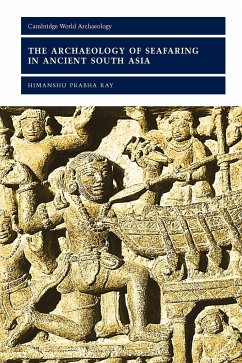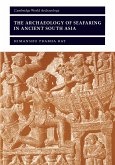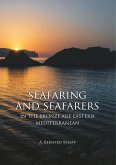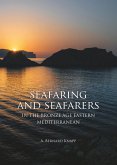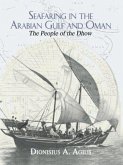Himanshu Prabha Ray
The Archaeology of Seafaring in Ancient South Asia
Himanshu Prabha Ray
The Archaeology of Seafaring in Ancient South Asia
- Gebundenes Buch
- Merkliste
- Auf die Merkliste
- Bewerten Bewerten
- Teilen
- Produkt teilen
- Produkterinnerung
- Produkterinnerung
This is an archaeological study of the Indian subcontinent's ancient maritime history, before European expansion.
Andere Kunden interessierten sich auch für
![The Archaeology of Seafaring in Ancient South Asia The Archaeology of Seafaring in Ancient South Asia]() Himanshu Prabha RayThe Archaeology of Seafaring in Ancient South Asia57,99 €
Himanshu Prabha RayThe Archaeology of Seafaring in Ancient South Asia57,99 €![Seafaring on the Ancient Mediterranean Seafaring on the Ancient Mediterranean]() Alec TilleySeafaring on the Ancient Mediterranean74,99 €
Alec TilleySeafaring on the Ancient Mediterranean74,99 €![Le Périple d'Hannon / The Periplus of Hanno Le Périple d'Hannon / The Periplus of Hanno]() Jacques RaminLe Périple d'Hannon / The Periplus of Hanno73,99 €
Jacques RaminLe Périple d'Hannon / The Periplus of Hanno73,99 €![Seafaring and Seafarers in the Bronze Age Eastern Mediterranean Seafaring and Seafarers in the Bronze Age Eastern Mediterranean]() A. Bernard KnappSeafaring and Seafarers in the Bronze Age Eastern Mediterranean28,99 €
A. Bernard KnappSeafaring and Seafarers in the Bronze Age Eastern Mediterranean28,99 €![Seafaring and Seafarers in the Bronze Age Eastern Mediterranean Seafaring and Seafarers in the Bronze Age Eastern Mediterranean]() A. Bernard KnappSeafaring and Seafarers in the Bronze Age Eastern Mediterranean83,99 €
A. Bernard KnappSeafaring and Seafarers in the Bronze Age Eastern Mediterranean83,99 €![Seafaring in the Arabian Gulf and Oman Seafaring in the Arabian Gulf and Oman]() Dionisius A. AgiusSeafaring in the Arabian Gulf and Oman67,99 €
Dionisius A. AgiusSeafaring in the Arabian Gulf and Oman67,99 €![Australia's Oldest Wreck Australia's Oldest Wreck]() Jeremy N. GreenAustralia's Oldest Wreck47,99 €
Jeremy N. GreenAustralia's Oldest Wreck47,99 €-
-
-
This is an archaeological study of the Indian subcontinent's ancient maritime history, before European expansion.
Hinweis: Dieser Artikel kann nur an eine deutsche Lieferadresse ausgeliefert werden.
Hinweis: Dieser Artikel kann nur an eine deutsche Lieferadresse ausgeliefert werden.
Produktdetails
- Produktdetails
- Verlag: Cambridge University Press
- Seitenzahl: 350
- Erscheinungstermin: 21. Juli 2010
- Englisch
- Abmessung: 260mm x 183mm x 23mm
- Gewicht: 854g
- ISBN-13: 9780521804554
- ISBN-10: 0521804558
- Artikelnr.: 29337491
- Herstellerkennzeichnung
- Libri GmbH
- Europaallee 1
- 36244 Bad Hersfeld
- gpsr@libri.de
- Verlag: Cambridge University Press
- Seitenzahl: 350
- Erscheinungstermin: 21. Juli 2010
- Englisch
- Abmessung: 260mm x 183mm x 23mm
- Gewicht: 854g
- ISBN-13: 9780521804554
- ISBN-10: 0521804558
- Artikelnr.: 29337491
- Herstellerkennzeichnung
- Libri GmbH
- Europaallee 1
- 36244 Bad Hersfeld
- gpsr@libri.de
Himanshu Prabha Ray is Associate Professor at the Centre for Historical Studies, Jawaharlal Nehru University.
Part I. Historiography and the Maritime Landscape: 1. The perspective
2. Historiography
3. The maritime landscape
4. Geographical knowledge of the Indian Ocean in antiquity: Part II. Fishing and Sailing Communities: Cross-Cultural Contacts
5. Marine and coastal resources
6. Maritime communities
7. Boat nomads
8. Piracy
9. Fishing communities: the historical record
10. Sailing communities: Part III. La Longue Durée: Transportation
Boat-Building Technology and Navigation: 11. Archaeology of the boat
12. The stitched tradition
13. Early European response
14. The ethnographic evidence
15. Boat-building centres
16. Traditional navigation
17. Ownership of vessels
18. Organisation of shipping
19. Organisation of shipping
20. Innovation and change
21. Repair and maintenance
22. Chronology of disjunction: Part IV. Maritime Trade Networks: The Beginnings (third-second millenia BCE)
23. Mesopotamian contacts
24. The Persian Gulf and early maritime networks
25. The Harappan civilization
26. The maritime regions of the Harappans
27. Networks of trade: internal
28. Transition and change: Part V. Regional Integration: (late second - first millennium BCE)
29. The Persian Gulf
30. Socotra
31. Peninsular India
32. Sri Lanka
33. Southeast Asia: Part VI. Consolidation of Political Structure: 34. The setting
35. Political concepts in early Buddhism: theory and practice
36. Satavahanas and their successors
37. Alliance as political strategy
38. The early policies in Sri Lanka
39. Political developments in early Southeast Asia
40. Royalty and ritual: Part VII. The Greeks: Adventurers, Traders and Travellers
41. The explorers
42. Hellenistic settlements
43. The Nabataeans, Sabeans and Gerrhaeans
44. The maritime network
45. Christian communities: Part VIII. Merchant Lineage and the Guild
46. Merchant communities and interaction with the state
47. Organisation of inland trade
48. The Indian Ocean network
49. Foreigners and trade networks
50. Money and the use of coins: Part IX. Multiple Meanings: Craft Production and Trade Networks: 51. The trading commodities
52. The textiles
53. Beads
54. Ivory
55. Metal artefacts
56. Organisation of crafts: Part X Shared Faith: 57. Social base of early Buddhism
58. The worship of the Stupa and the Relics
59. Pilgrimage
60. Ritual and ceremony
61. Buddhism and maritime activity
62. Archaeology of monastic sites
63. Continuity and change: Part XI. Retrospect and Prospect: 64. In conclusion
65. Future research strategy.
2. Historiography
3. The maritime landscape
4. Geographical knowledge of the Indian Ocean in antiquity: Part II. Fishing and Sailing Communities: Cross-Cultural Contacts
5. Marine and coastal resources
6. Maritime communities
7. Boat nomads
8. Piracy
9. Fishing communities: the historical record
10. Sailing communities: Part III. La Longue Durée: Transportation
Boat-Building Technology and Navigation: 11. Archaeology of the boat
12. The stitched tradition
13. Early European response
14. The ethnographic evidence
15. Boat-building centres
16. Traditional navigation
17. Ownership of vessels
18. Organisation of shipping
19. Organisation of shipping
20. Innovation and change
21. Repair and maintenance
22. Chronology of disjunction: Part IV. Maritime Trade Networks: The Beginnings (third-second millenia BCE)
23. Mesopotamian contacts
24. The Persian Gulf and early maritime networks
25. The Harappan civilization
26. The maritime regions of the Harappans
27. Networks of trade: internal
28. Transition and change: Part V. Regional Integration: (late second - first millennium BCE)
29. The Persian Gulf
30. Socotra
31. Peninsular India
32. Sri Lanka
33. Southeast Asia: Part VI. Consolidation of Political Structure: 34. The setting
35. Political concepts in early Buddhism: theory and practice
36. Satavahanas and their successors
37. Alliance as political strategy
38. The early policies in Sri Lanka
39. Political developments in early Southeast Asia
40. Royalty and ritual: Part VII. The Greeks: Adventurers, Traders and Travellers
41. The explorers
42. Hellenistic settlements
43. The Nabataeans, Sabeans and Gerrhaeans
44. The maritime network
45. Christian communities: Part VIII. Merchant Lineage and the Guild
46. Merchant communities and interaction with the state
47. Organisation of inland trade
48. The Indian Ocean network
49. Foreigners and trade networks
50. Money and the use of coins: Part IX. Multiple Meanings: Craft Production and Trade Networks: 51. The trading commodities
52. The textiles
53. Beads
54. Ivory
55. Metal artefacts
56. Organisation of crafts: Part X Shared Faith: 57. Social base of early Buddhism
58. The worship of the Stupa and the Relics
59. Pilgrimage
60. Ritual and ceremony
61. Buddhism and maritime activity
62. Archaeology of monastic sites
63. Continuity and change: Part XI. Retrospect and Prospect: 64. In conclusion
65. Future research strategy.
Part I. Historiography and the Maritime Landscape: 1. The perspective
2. Historiography
3. The maritime landscape
4. Geographical knowledge of the Indian Ocean in antiquity: Part II. Fishing and Sailing Communities: Cross-Cultural Contacts
5. Marine and coastal resources
6. Maritime communities
7. Boat nomads
8. Piracy
9. Fishing communities: the historical record
10. Sailing communities: Part III. La Longue Durée: Transportation
Boat-Building Technology and Navigation: 11. Archaeology of the boat
12. The stitched tradition
13. Early European response
14. The ethnographic evidence
15. Boat-building centres
16. Traditional navigation
17. Ownership of vessels
18. Organisation of shipping
19. Organisation of shipping
20. Innovation and change
21. Repair and maintenance
22. Chronology of disjunction: Part IV. Maritime Trade Networks: The Beginnings (third-second millenia BCE)
23. Mesopotamian contacts
24. The Persian Gulf and early maritime networks
25. The Harappan civilization
26. The maritime regions of the Harappans
27. Networks of trade: internal
28. Transition and change: Part V. Regional Integration: (late second - first millennium BCE)
29. The Persian Gulf
30. Socotra
31. Peninsular India
32. Sri Lanka
33. Southeast Asia: Part VI. Consolidation of Political Structure: 34. The setting
35. Political concepts in early Buddhism: theory and practice
36. Satavahanas and their successors
37. Alliance as political strategy
38. The early policies in Sri Lanka
39. Political developments in early Southeast Asia
40. Royalty and ritual: Part VII. The Greeks: Adventurers, Traders and Travellers
41. The explorers
42. Hellenistic settlements
43. The Nabataeans, Sabeans and Gerrhaeans
44. The maritime network
45. Christian communities: Part VIII. Merchant Lineage and the Guild
46. Merchant communities and interaction with the state
47. Organisation of inland trade
48. The Indian Ocean network
49. Foreigners and trade networks
50. Money and the use of coins: Part IX. Multiple Meanings: Craft Production and Trade Networks: 51. The trading commodities
52. The textiles
53. Beads
54. Ivory
55. Metal artefacts
56. Organisation of crafts: Part X Shared Faith: 57. Social base of early Buddhism
58. The worship of the Stupa and the Relics
59. Pilgrimage
60. Ritual and ceremony
61. Buddhism and maritime activity
62. Archaeology of monastic sites
63. Continuity and change: Part XI. Retrospect and Prospect: 64. In conclusion
65. Future research strategy.
2. Historiography
3. The maritime landscape
4. Geographical knowledge of the Indian Ocean in antiquity: Part II. Fishing and Sailing Communities: Cross-Cultural Contacts
5. Marine and coastal resources
6. Maritime communities
7. Boat nomads
8. Piracy
9. Fishing communities: the historical record
10. Sailing communities: Part III. La Longue Durée: Transportation
Boat-Building Technology and Navigation: 11. Archaeology of the boat
12. The stitched tradition
13. Early European response
14. The ethnographic evidence
15. Boat-building centres
16. Traditional navigation
17. Ownership of vessels
18. Organisation of shipping
19. Organisation of shipping
20. Innovation and change
21. Repair and maintenance
22. Chronology of disjunction: Part IV. Maritime Trade Networks: The Beginnings (third-second millenia BCE)
23. Mesopotamian contacts
24. The Persian Gulf and early maritime networks
25. The Harappan civilization
26. The maritime regions of the Harappans
27. Networks of trade: internal
28. Transition and change: Part V. Regional Integration: (late second - first millennium BCE)
29. The Persian Gulf
30. Socotra
31. Peninsular India
32. Sri Lanka
33. Southeast Asia: Part VI. Consolidation of Political Structure: 34. The setting
35. Political concepts in early Buddhism: theory and practice
36. Satavahanas and their successors
37. Alliance as political strategy
38. The early policies in Sri Lanka
39. Political developments in early Southeast Asia
40. Royalty and ritual: Part VII. The Greeks: Adventurers, Traders and Travellers
41. The explorers
42. Hellenistic settlements
43. The Nabataeans, Sabeans and Gerrhaeans
44. The maritime network
45. Christian communities: Part VIII. Merchant Lineage and the Guild
46. Merchant communities and interaction with the state
47. Organisation of inland trade
48. The Indian Ocean network
49. Foreigners and trade networks
50. Money and the use of coins: Part IX. Multiple Meanings: Craft Production and Trade Networks: 51. The trading commodities
52. The textiles
53. Beads
54. Ivory
55. Metal artefacts
56. Organisation of crafts: Part X Shared Faith: 57. Social base of early Buddhism
58. The worship of the Stupa and the Relics
59. Pilgrimage
60. Ritual and ceremony
61. Buddhism and maritime activity
62. Archaeology of monastic sites
63. Continuity and change: Part XI. Retrospect and Prospect: 64. In conclusion
65. Future research strategy.

